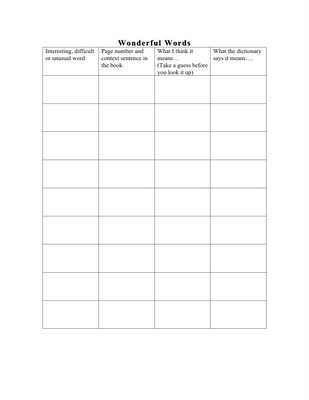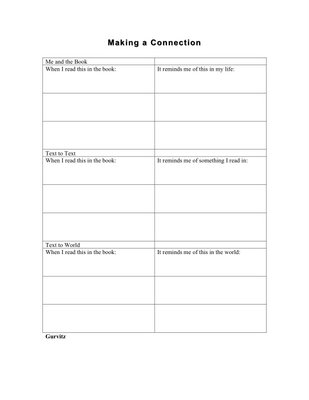Scaffolded Independent-Level Reading Book Basket
(Keisha Thomas)
Color Code Red-Books for 1-2 graders
A Picture Book of Helen Keller by David A. Adler– A picture book which tells the story of Helen Keller simply and accurately with great illustrations.
Laura Ingalls Wilder by William T. Anderson- A biography of Laura Ingalls Wilder, whose life on the American prairie became the basis for her "Little House" books.
Color Code Orange Books for 3-5 graders
On the Course with... Tiger Woods (Matt Christopher Sports Biographies Series) by Glenn Stout- This book talks about the personal background and golf career of the young man.
Jackie Robinson: Strong Inside and Out (TFK Biographies Series) by Editors of TIME for Kids, Denise Lewis Patrick –This publication covers the biography of a Negro whose baseball career inspired blacks and opened the door for blacks to participate in professional sports.
Freedom Train: The Story of Harriet Tubman by Dorothy Sterling – A beautiful biography about the black woman who helped free slaves through the Underground Railroad.
Color Code Yellow Books for 6-8 graders
Small Steps: The Year I Got Polio by Peg Kehret - The author was the first child in Austin, Minnesota to contract Polio she describes her battle against polio when she was thirteen and her efforts to overcome its debilitating effects.
Woodsong by Gary Paulsen- This story tells of one man’s account of his first Iditarod, a dogsled race across Alaska.
Walt Disney: Young Movie Maker (Childhood of Famous Americans Series)
by Marie Hammontree - A biography concentrating on the boyhood of the cartoonist and film maker who created Mickey Mouse.
Responses
1. Wonderful Words students collect words that are interesting, unusual, difficult, or unique to the text in some way. They list these words including the page number and context where the word is found in the text, before looking up the word, students provide an approximate meaning (Take a Guess), and finally, students include a dictionary definition. Students can fold their notebook paper in four columns for the same effect. (Worksheet Included)
2. Making a Connection It is important for students to become aware of the connections they make during reading. These associations can involve connections to themselves, other books, and the world. On the work sheet, students identify the place in the text that triggers the connection. They describe the link they make with this connection. (Worksheet Included)


A Picture Book of Helen Keller by David A. Adler– A picture book which tells the story of Helen Keller simply and accurately with great illustrations.
Laura Ingalls Wilder by William T. Anderson- A biography of Laura Ingalls Wilder, whose life on the American prairie became the basis for her "Little House" books.
Color Code Orange Books for 3-5 graders
On the Course with... Tiger Woods (Matt Christopher Sports Biographies Series) by Glenn Stout- This book talks about the personal background and golf career of the young man.
Jackie Robinson: Strong Inside and Out (TFK Biographies Series) by Editors of TIME for Kids, Denise Lewis Patrick –This publication covers the biography of a Negro whose baseball career inspired blacks and opened the door for blacks to participate in professional sports.
Freedom Train: The Story of Harriet Tubman by Dorothy Sterling – A beautiful biography about the black woman who helped free slaves through the Underground Railroad.
Color Code Yellow Books for 6-8 graders
Small Steps: The Year I Got Polio by Peg Kehret - The author was the first child in Austin, Minnesota to contract Polio she describes her battle against polio when she was thirteen and her efforts to overcome its debilitating effects.
Woodsong by Gary Paulsen- This story tells of one man’s account of his first Iditarod, a dogsled race across Alaska.
Walt Disney: Young Movie Maker (Childhood of Famous Americans Series)
by Marie Hammontree - A biography concentrating on the boyhood of the cartoonist and film maker who created Mickey Mouse.
Responses
1. Wonderful Words students collect words that are interesting, unusual, difficult, or unique to the text in some way. They list these words including the page number and context where the word is found in the text, before looking up the word, students provide an approximate meaning (Take a Guess), and finally, students include a dictionary definition. Students can fold their notebook paper in four columns for the same effect. (Worksheet Included)
2. Making a Connection It is important for students to become aware of the connections they make during reading. These associations can involve connections to themselves, other books, and the world. On the work sheet, students identify the place in the text that triggers the connection. They describe the link they make with this connection. (Worksheet Included)


2 comments:
Thank you for the information.
These animals as beasts of burden, hunters we’re undoubtedly part of the clans that crossed into North America from Siberia. Who’s to say that those early men would’ve survived without them. All living things are part of the whole. Nature from a Homo sapiens viewpoint is cruel and brutish and we somehow think that we know better. I don’t think if you asked nature that it would agree with that. Animals provided food, clothing, protection, fuel oil and because of our technology we have more than enough resources without using animals. Foie Gras pate to many is a delicacy and to others is an abomination. Frankly, I think we should start with man’s inhumanity to man. Interesting read, thanks.
Post a Comment